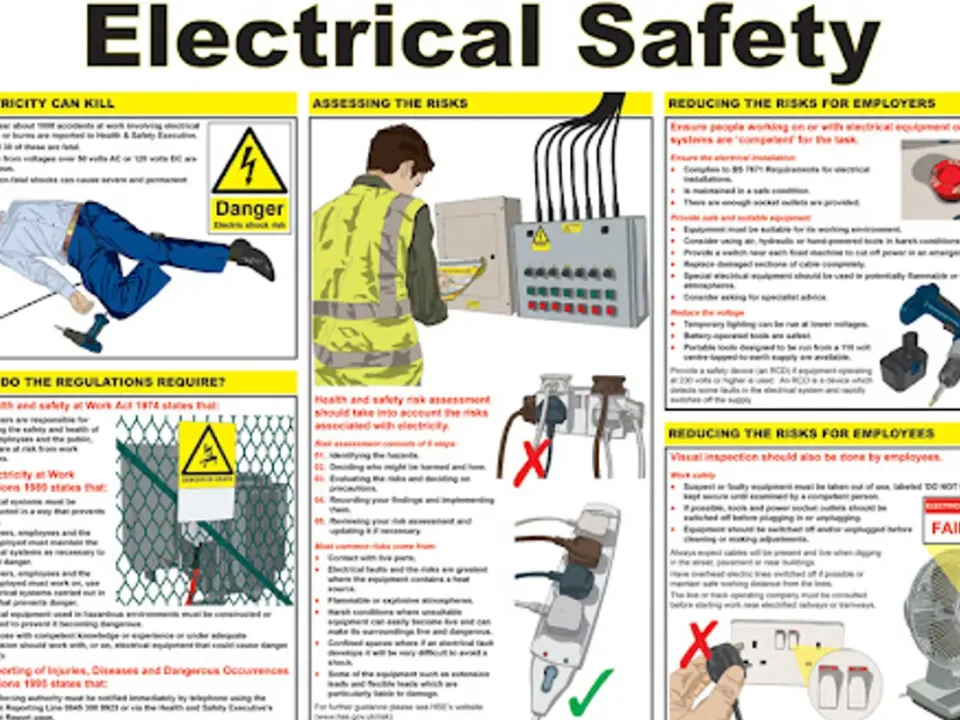Demystifying the Dangers: Exploring the Risks of Lithium Batteries and How to Mitigate Them

Enhancing Workplace Safety: The Importance of Conducting an Electrical Safety Audit
June 28, 2023HAZOP Training for Emerging Industries: Exploring Unique Challenges – The Safety Master
June 30, 2023Demystifying the Dangers: Exploring the Risks of Lithium Batteries and How to Mitigate Them
The power of lithium batteries cannot be overstated. These small, rechargeable powerhouses have revolutionized the modern world, powering our smartphones, laptops, electric vehicles, and countless other devices. However, behind their impressive capabilities lies a hidden danger that demands our attention.
In this detailed exploration of the risks associated with lithium batteries and how to effectively mitigate them, we will delve into the causes of battery failures and offer practical solutions to ensure safe handling. By the end of this article, you will have gained valuable insights into preventing accidents and safeguarding yourself from potential harm.
The Power of Lithium Batteries: Revolutionizing the Modern World
Lithium batteries, with their remarkable capabilities, have emerged as a game-changer in our fast-paced, technology-driven society. These small powerhouses have revolutionized the way we live, work, and play, bringing about a new era of efficiency and convenience.
One of the most significant advantages of lithium batteries lies in their incredibly high energy density. This means they can store an immense amount of electrical energy within their compact design, delivering unrivaled power to a wide range of devices. From smartphones and laptops to electric vehicles and renewable energy systems, lithium batteries have permeated nearly every aspect of our lives.
Furthermore, the lightweight nature of lithium batteries makes them ideal for portable applications. Gone are the days when we were restricted by heavy and bulky power sources. Thanks to lithium technology, we now enjoy unprecedented mobility without compromising on performance.
As if these benefits weren’t enough, lithium batteries also exhibit an impressive rechargeability. Unlike traditional disposable batteries that end up polluting landfills after use, lithium batteries can be recharged hundreds or even thousands of times before needing replacement. This not only saves money but also contributes to a greener future by reducing waste.
In essence, the power and versatility offered by lithium batteries have transformed our modern world into a more connected and efficient place. With each technological advancement in this field comes renewed hope for improved sustainability and breakthrough innovations that will continue to shape our future for the better.
Uncovering the Potential Dangers: Understanding the Risks of Lithium Batteries
As we revel in the marvels of modern technology, it is imperative that we delve into the depths of understanding the risks associated with the seemingly omnipotent lithium batteries. While these energy powerhouses have revolutionized our lives in ways unimaginable, they come with their own set of hazards that demand our attention.
Lithium batteries possess an inherent susceptibility to thermal runaway, a phenomenon where excessive heat leads to a self-sustaining chemical reaction, resulting in catastrophic consequences. The highly reactive nature of lithium within these batteries makes them prone to heat-induced degradation, which can rapidly escalate into fires or explosions if not handled with utmost care. Moreover, internal short circuits caused by manufacturing defects or user mishandling can trigger violent reactions within these energetic power sources.
The Hidden Culprits: Common Causes of Lithium Battery Failures
Within the realm of lithium batteries, a multitude of factors can lead to unexpected failures and subsequent risks. Understanding these common culprits is vital for effectively mitigating the dangers associated with these power sources. One prominent cause of lithium battery failures is thermal runaway, which occurs when excessive heat triggers a chain reaction within the battery, resulting in overheating and potentially leading to combustion or explosion.
Another common cause is mechanical damage, often resulting from mishandling or improper storage. Lithium batteries are highly sensitive to physical impact, and even minor punctures or dents can compromise their structural integrity, causing internal short circuits and hazardous outcomes. Furthermore, manufacturing defects such as faulty cell design or inadequate quality control processes can also contribute to battery failures.
Preventive Measures: How to Safely Handle Lithium Batteries
When it comes to the safe handling of lithium batteries, knowledge is indeed power. Understanding the potential risks and taking proactive steps can go a long way in ensuring not only your personal safety but also the longevity and efficiency of these remarkable power sources. So, let’s delve into some essential preventive measures that will help you handle lithium batteries with confidence.
Maintain Optimal Temperature: Lithium batteries are highly sensitive to temperature fluctuations. Extreme heat or cold can significantly impact their performance and even lead to hazardous situations. It is crucial, therefore, to store lithium batteries within a recommended temperature range of 15-25 degrees Celsius (59-77 degrees Fahrenheit). Avoid exposing them to direct sunlight or extremely low temperatures, particularly during charging or discharging processes.
Avoid Physical Damage: While lithium batteries may appear sturdy, they are susceptible to physical damage that can compromise their internal structure and integrity. Ensure you handle them with care, avoiding any unnecessary impacts or drops. It is advisable to store them in protective cases when not in use and refrain from stacking or piling items on top of them. By treating these batteries with respect and gentleness, you can significantly reduce the risk of potential accidents.
Use Compatible Chargers: When charging your lithium battery, always use chargers specifically designed for lithium-ion cells. Using incompatible chargers may result in overcharging or overheating, leading to dangerous outcomes such as thermal runaway. Additionally, refrain from using damaged charging cables or adapters as they can introduce electrical faults that pose further risks
The Ultimate Guide to Mitigating Lithium Battery Risks
When it comes to the world of lithium batteries, knowledge is power, quite literally. Armed with the right information and a proactive approach, you can ensure a safer and more efficient experience with these remarkable power sources. Allow us to guide you through a comprehensive set of strategies and precautions that will help you mitigate the risks associated with lithium batteries.
First and foremost, it is essential to emphasize the significance of selecting high-quality lithium batteries from reputable manufacturers. Remember, not all batteries are created equal. Investing in reliable brands known for their commitment to safety standards will greatly reduce the chances of encountering any mishaps. Additionally, ensuring compatibility between your device and the battery is crucial; make sure they are designed to work seamlessly together.
Safety First: Proper Storage and Transport of Lithium Batteries
When it comes to the safe handling of lithium batteries, proper storage and transport are paramount. These powerful energy sources demand our utmost attention and care. To ensure the well-being of both humans and the environment, it is crucial to adhere to a set of guidelines in storing and transporting these potent energy cells.
Firstly, it is imperative to keep lithium batteries in a cool, dry place away from direct sunlight or extreme temperatures. This helps preserve their chemical stability and reduces the risk of potential thermal runaway incidents. Additionally, storing them in fire-resistant containers or cabinets provides an added layer of protection against external hazards.
Moreover, when transporting lithium batteries, appropriate packaging is essential to prevent any damage or leakage. Utilizing specialized containers that offer shock absorption and insulation safeguards against physical impacts while minimizing the chances of short circuits. Adhering strictly to regulations set forth by relevant authorities ensures compliance with safety standards that protect both individuals handling these batteries and those around them.
A Hands-On Approach: Tips for Using Lithium Batteries Responsibly
When it comes to harnessing the power of lithium batteries, responsible usage is paramount. With their unrivaled energy density and long-lasting capabilities, these technological marvels have become indispensable in our modern lives. To ensure their safe and efficient utilization, here are some essential tips to keep in mind:
1. Mindful Charging: One of the key aspects of responsible lithium battery usage is being cautious during the charging process. Always use chargers specifically designed for lithium batteries and avoid overcharging them, as this can lead to overheating and potential hazards. Additionally, never leave batteries unattended while they are charging to minimize any unforeseen mishaps.
2. Temperature Awareness: Lithium batteries are sensitive creatures when it comes to temperature fluctuations. Extreme heat or cold can adversely affect their performance and lifespan. It is crucial to store and use these batteries within recommended temperature ranges provided by manufacturers. By doing so, you can ensure that your lithium battery operates optimally and safely.
3. Avoid Physical Damage: While lithium batteries may seem robust, they are not impervious to physical damage. Avoid dropping or subjecting them to unnecessary force, as this can compromise their internal structure leading to performance degradation or even leakage of hazardous chemical components.
4. Compatibility Matters: When selecting a device that utilizes a lithium battery, always ensure compatibility between the battery and the gadget it powers. Using incompatible batteries may cause irregularities in voltage supply or result in poor functionality at best – or worse still – damage both the device and battery irreparably.
By adhering to these
When Disaster Strikes: Effective Strategies for Dealing with Lithium Battery Failures
In the unfortunate event of a lithium battery failure, it is crucial to be prepared and equipped with the knowledge of effective strategies to mitigate the potential risks. While such occurrences might be rare, understanding how to handle them can make all the difference in ensuring safety and minimizing damage.
The first step when confronted with a lithium battery failure is to act swiftly, but calmly. Safely remove any nearby flammable materials and evacuate the area if necessary. If a fire ensues, make use of appropriate fire suppression equipment or extinguishing agents specifically designed for lithium battery fires. Remember, quick action can prevent the situation from escalating further.
Moreover, it’s essential to inform emergency services immediately. Their expertise and specialized equipment can aid in containing and resolving the situation effectively. Additionally, providing accurate information about the type of lithium battery involved will assist responders in selecting the most appropriate course of action.
Ultimately, by following these strategies diligently and staying proactive during such challenging circumstances, we can ensure that even in moments of crisis, safety prevails over adversity.
Keeping the Environment in Mind: Responsible Disposal of Lithium Batteries
Lithium batteries have undoubtedly revolutionized the way we power our devices, but their environmental impact cannot be overlooked. Improper disposal of these batteries can result in severe consequences for our planet. However, by adopting responsible disposal practices, we can mitigate these risks and ensure a brighter future for generations to come.
When it comes to disposing of lithium batteries, it is crucial to remember that they contain potentially hazardous materials. These materials pose a threat when exposed to the environment or improperly handled. Therefore, it is essential to utilize designated battery recycling programs or collection centers that specialize in handling these types of batteries.
These recycling facilities not only ensure the safe extraction of valuable components from lithium batteries but also prevent harmful substances from entering landfills or contaminating water sources. By properly disposing of lithium batteries through these channels, we contribute to reducing pollution and conserving resources.
The Future of Lithium Batteries: Advancements and Innovations for Increased Safety
As the demand for lithium batteries continues to surge, so does the need for advancements and innovations that prioritize safety without compromising efficiency. The future of lithium batteries holds immense promise, with scientists and researchers worldwide tirelessly working towards developing groundbreaking technologies that address the risks associated with these powerful energy storage devices.
One exciting avenue of research revolves around enhancing the thermal stability of lithium batteries. By incorporating novel materials and engineering techniques, experts aim to minimize the likelihood of thermal runaway – a phenomenon where excessive heat generation leads to battery failure. Imagine a world where you can confidently use your smartphone or electric vehicle without worrying about potential overheating incidents!
Sanjeev Paruthi
TSM TheSafetyMaster® Private Limited
Unit No 221-451-452, SPL1/J, 2nd & 4th Floor, Sunsquare Plaza Complex, RIICO Chowk, Bhiwadi 301019, Rajasthan, India
Phone: +91 1493 22 0093
Mobile: +91 7665231743/9413882016
Email: info@thesafetymaster.com




